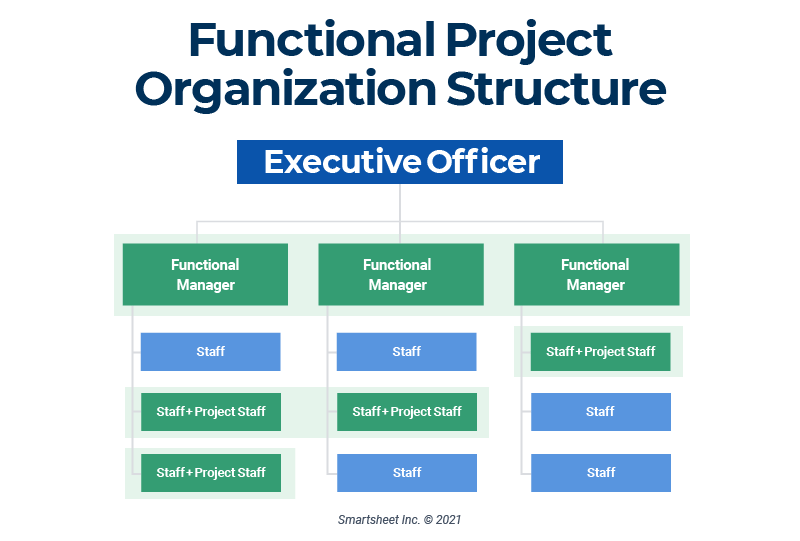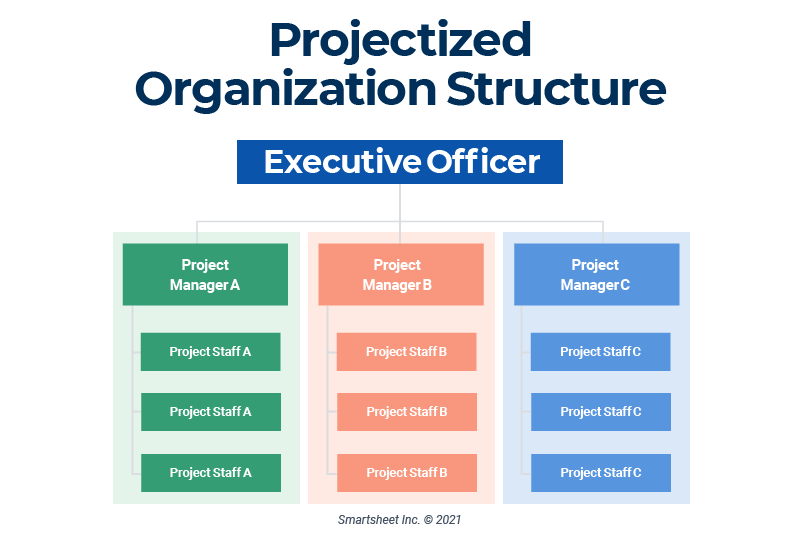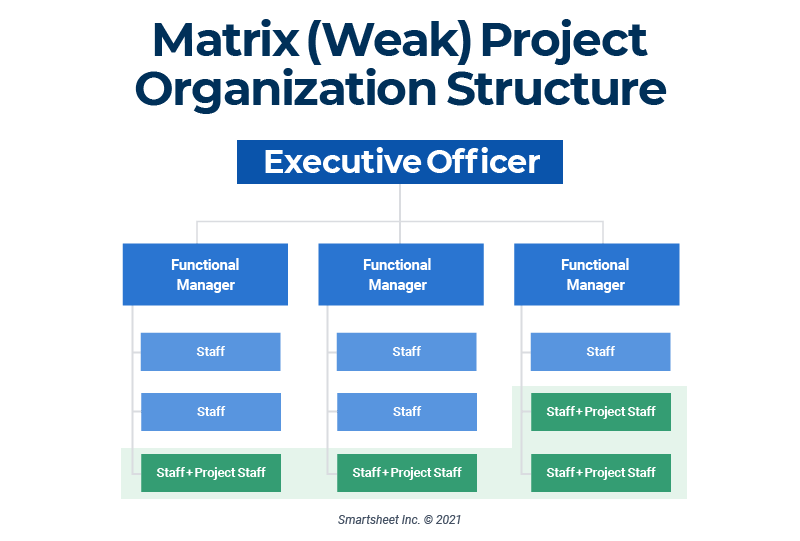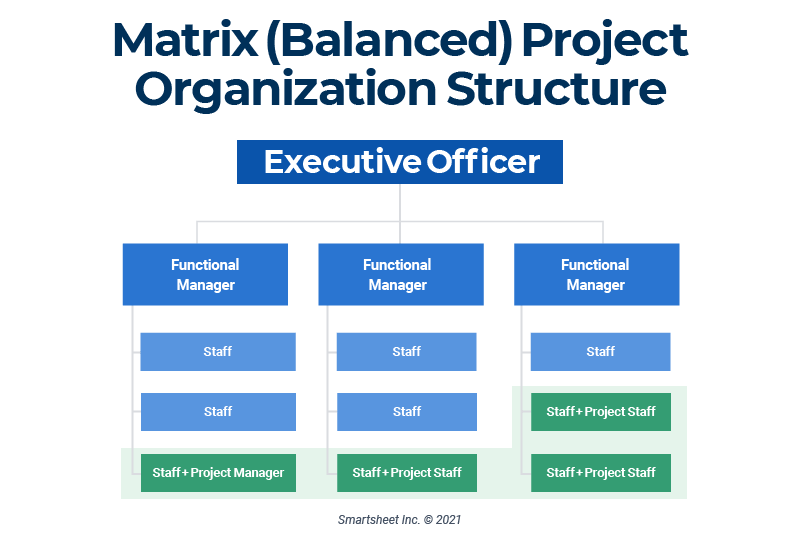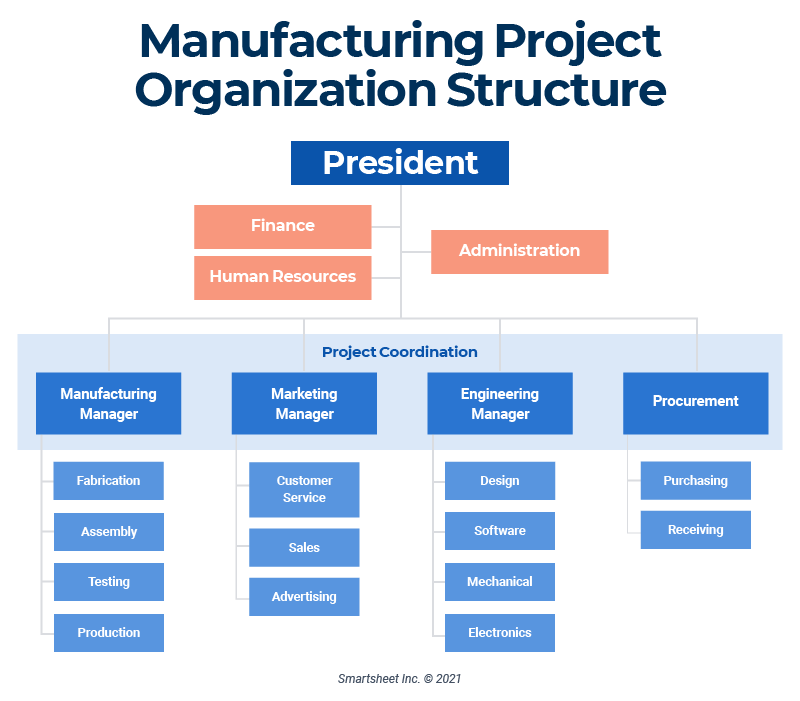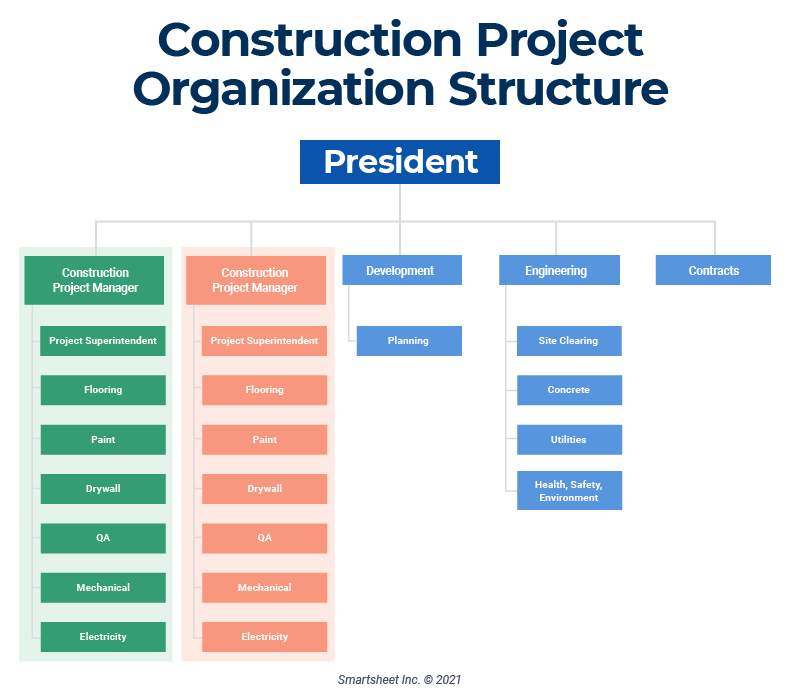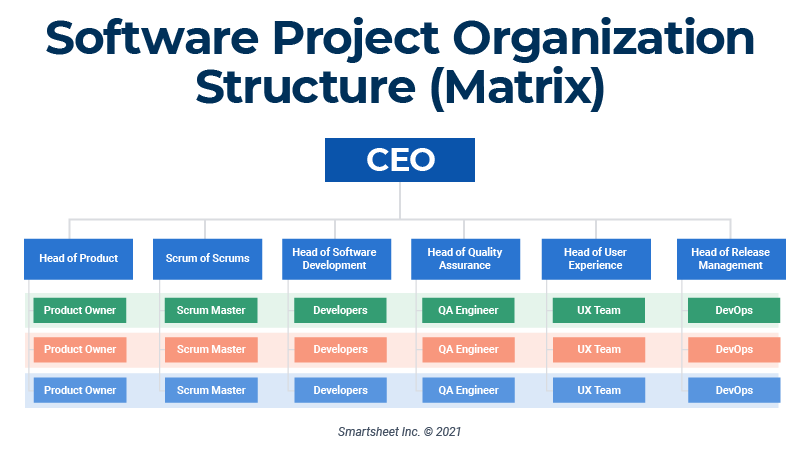What Is Project Organization in Project Management?
The term project organization refers to the style of coordination, communication, and management the project team uses throughout a project lifecycle. By applying project organization, you optimize resources, provide clear communication about roles and responsibilities, and reduce potential roadblocks.
Why Is Project Organization Important?
Project managers use project organization to align team members before and during a project. The process minimizes disruption to your workflow and conflict among team members, as well as leads to maximum productivity among team members involved in a project.
While excellent project organization strategy and execution are important, you also need to consider the opportunity cost of a poorly organized project.
Anthony C. Taylor, Managing Partner and Lead Facilitator at SME Strategy Management Consulting, works with senior leadership to help strategically implement organizational management. He notes that the positive attributes of project organization are to prioritize and better allocate resources, keeping in mind that the project will have various stakeholders. According to Taylor, if project organization and strategy are not an essential part of a project, it’s easy to fall into the “multiple destination trap” where people don’t know where they’re going. This creates different expectations among the team members, causing them to spin in circles and avoid risk. Well-executed project management organization is part of what creates a “one destination” solution, says Taylor, where everyone knows where they’re going to ultimately deliver business value.
Taylor elaborates on the opportunity cost: “What does it cost if it’s not working for you? If team members are not focused on the right priorities, they will do x, y, and z outside of the project priorities and inhibit progress. If people aren’t clear where they’re going, they’ll quit without knowing the wants, needs, and expectations of everyone around them. What then is the cost to attract, hire, retrain, and lose productivity?”
Creating and communicating a project management organization structure is one tool to help connect strategy and vision across those involved in the project. Developing a project organization structure ultimately reduces disruptions, overlaps, conflicts, uncertainty, and confusion before a project even begins.
What Is Organizational Structure in Project Management?
A project management organizational structure is used to determine the hierarchy and authority of people involved in a specific project. The structure defines each team member’s function and the reporting lines on a chart for team members to reference during a project.
Types of Project Organizational Structures
There are three types of organizational structures in project management: functional, matrix, and projectized. Each project structure framework is determined by the authority, roles, and responsibilities of the team members within the existing organizational structure.
Because no two projects are alike, no organizational structure will be exactly the same. The role of the project manager changes within each of these frameworks, and each project’s organizational structure is highly nuanced. Understanding the vertical or horizontal coordination of each framework and the role that the project manager will hold can help you to develop a successful strategy.
Functional Project Organizational Structure
A functional project organizational structure organizes its hierarchy around traditionally functioning departments. A functional manager heads each department and reports to an executive. These functional managers — not other staff — coordinate the project, and they select team members from each department to support the project, in addition to their functional responsibilities.
Projectized Organizational Structure
A projectized or project-based organizational structure creates a dedicated project division within an organization. The project coordination operates vertically under this division. Project managers maintain sole authority for the project and are assigned dedicated staff who work toward project goals.
Matrix Organizational Structure
A matrix organizational structure is set up on a grid to demonstrate staff reporting patterns to more than one authority. It is a hybrid of functional and projectized organizational structures, and project managers share authority with other program managers in this structure. Depending on the decision-making capacity of the project manager, a matrix structure is one of three subtypes: weak, balanced, or strong.
Weak Structure
A weak structure is similar to the functional organization structure, in which coordination occurs horizontally among staff without a designated project manager. The primary difference between a weak matrix and a functional structure is that the staff across departments, rather than the functional managers, coordinate the project (but the functional manager maintains decision-making authority).
Balanced Structure
In a balanced matrix, the project manager also holds a staff position and does not utilize the project manager role to its full capacity. The project manager still has little authority over project decisions, budget, staff, etc., and primarily serves as the point of contact and coordinator.
Strong Structure
A strong matrix is most similar to a projectized organizational structure. In it, a dedicated project manager falls under a functional project management department, has dedicated cross-functional staff, and is supported by a manager of all the project managers. This subtype offers the project manager the most authority as they work across a matrixed environment.
There is no perfect organizational structure. Instead, a project manager must weigh the pros and cons of resource allocation and optimization within each structure, then select the most optimal structure. In addition to the project team’s operational pros and cons, the authority (decision-making power) of the project manager changes depending on the selected project organization structure. This means that the project manager must have both the knowledge and the skills to apply effective managerial and interpersonal techniques that lead to a high-functioning project team.
Project Organizational Structure Quick-Reference Guide
Use this quick-reference guide to help determine the pros and cons of your project organization structure, as well as the managerial skills you need to prioritize in order to ensure your project runs as smoothly as possible.
| FUNCTIONAL | ||
|---|---|---|
| Project Pros | Project Cons | Management Priorities for a Project Manager |
Optimal Resources: Resources are not in competition with other areas, which leaves little need for competition or negotiation. Familiarity: Team members are already familiar with each other and share similar skills and functions. Operational Efficiency: Has the potential to achieve greatest operational efficiency due to the role and communication clarity. | Missing the Right People: Projects may need additional specialists if they do not have all the right people within the area. Competing Priorities of Team: Team members may feel challenged to balance competing priorities of program responsibilities and project responsibilities. Siloed: This structure often creates organizational silos, which can make strategic alignment challenging. | PM Authority: Low Communication Facilitation: Break down silos across departments. Coordination: Engage cross-functional teams. Teamwork Emphasis: Engage teams outside of their department. Continuous Goal Clarity: Keep project goals at the forefront in competition with departmental goals distracting the project. |
| MATRIX | ||
| Project Pros | Project Cons | Management Priorities for a Project Manager |
People Optimization: Leverages each specialist’s skill set across multiple projects. Flexibility: Employees can work across departmental units without being bound to one. Project Control: Strong coordination among team members eases communication and information boundaries. | Costs: Administrative costs are higher, due to the operational complexity of the reporting relationships. Workload Miscommunication: There is a greater potential for misunderstanding a team's workload, given that they report both to a project manager and a department manager. Increased Conflict: Shared authority among managers potentially creates confusion on roles. | PM Authority: Medium Influencing and Negotiation Skills: Navigate limited authority with other program managers and interactions with the project team members. Servant Leadership: Focus on building deep collaboration and communication with the team, and continuously monitor the division of labor. Open Communication Lines: These boundaries are essential to spot and resolve conflicts before bigger issues come up. Team Recognition: Acknowledge the team comes from multiple parts of the organization. Take time for team building and engagement opportunities. |
| PROJECTIZED | ||
| Project Pros | Project Cons | Management Priorities for a Project Manager |
Authority: The project manager owns all project decision making. Clarity: Project alignment, lines, goals, and strategy are clear across the team. | Resource Duplication: Resources may not be optimized and can be costly, due to the doubling of resources across multiple projects. Stunted Team Growth: Teams can be siloed, binding the team members to one project at a time and limiting their growth. | PM Authority: High Role Responsibility: Live up to the trust and leadership that comes with full authority and ownership of the project. Maintain Team Morale: Build team trust and keep the team moving to meet tight deadlines. Communication: Building strong communication networks across projects is essential in reducing the duplication of efforts. |
Some organizations adopt a dedicated project management office (PMO) due to the high volume and variety of projects. This allows for better visibility of projects across the organization, improves resource allocation, and increases productivity and ROI across projects. Read our article with expert tips and best practices for PMOs.
Features of an Organization Structure
The features of an organizational structure define the roles and relationships among members of the project, as well as between projects. These relationships are determined by authority, communication lines, coordination, supervision, and responsibilities.
Specifically, the primary features of a organizational structure are as follows:
- Hierarchy: The hierarchy should delineate a clear line of authority and define decision-making responsibilities.
- Division of Labor: This refers to the workload (managerial, task oriented, etc.) associated with the roles.
- Span of Control: Here, define who manages whom. Reporting structures will be based on this concept.
- Position Type (Line vs. Staff): A line position is a team member who is directly involved with the product. A staff position supports those in line positions, but are not directly involved with the product.
- Centralization: This defines how the decision making occurs. In a centralized project, few people own decisions, whereas in a decentralized project, decision-making authority is distributed across the organization.
How to Make a Project Organizational Chart
To make a project organizational chart, first assess the goals of the project, identify the core team, and assign them appropriate roles to the project. Develop the organizational chart by mapping out the roles and responsibilities of each team member.
The PM will make the organizational chart during the initiation phase of the project so that the project manager can communicate with team members before the project begins. The team will then use it in the project planning phase to help divide tasks among team members. Doing so provides a clear understanding of each role, empowers team members to own their roles, and brings respect to other positions within the project, which immediately builds trust.
The project organizational structure needs to be flexible and might require adjustments during the other phases of the project. Make sure to communicate any adjustments to the organizational chart (including staffing decisions) to the team members.
Developing a project organizational chart requires the following six main steps:
Step 1: Align the Project with Organizational Strategy
The project manager must have a deep understanding of how the project goals align with the company or department’s strategy. This will bring the team onboard from the beginning, develop shared meaning from project team members, and ultimately provide the most seamless project execution.
Step 2: Analyze Projects on an Organizational Level
If an organization doesn’t have a PMO, the project manager must analyze the volume and variety of projects when considering which organizational structure to select. The Project Management Institute (PMI) uses the volume-variety matrix, a diagram that charts an organization’s volume of projects in relation to the variety of projects on a low-to-high continuum, to assist in determining a project organization structure strategy. A high variety and low volume of projects suggests a projectized structure would best fit, whereas a low variety and high volume of projects would suggest a functional structure. A matrix structure falls in between these two spectrums.
Step 3: Determine Roles and Responsibilities
Focus on the necessary roles and responsibilities first, before considering personnel. If a project manager has the authority to decide who is on the team, it is important to research potential team members to find the most suitable people for the project. Regardless of how the core team is assembled, it is essential to understand the strengths that each team member brings to the project. Spend time getting to know everyone on the team; in the process, you can build rapport and assess their skills.
Step 4: Structure the Chart
Structuring a chart can be complex, but you can make the process easier by approaching it from the large structure to task details, or vice versa. Start by reviewing the strengths of the team, the project tasks that need to be completed, and the existing structure of the organization. Decide which people’s strengths fall into leadership roles and which people are more task oriented.
Naturally, the organizational structure will begin to emerge as one of the three types of organizational structures. Map out the workflow, reporting, and hierarchical roles and compare them to see if a different organizational structure would be more fitting. Depending on your learning style, it may be helpful to use sticky notes to move team members around before drafting your structure online. As you plan, ensure that you distribute the workload evenly among the team.
Step 5: Finalize the Organizational Chart
Develop and finalize the visual representation of the organizational chart. Include names and contact information for team members to easily correspond with each other throughout the project. Read this roundup of organizational structure templates to quickly create and adapt to your project team.
Step 6: Communicate
A project organizational chart is only as good as the number of team members who are aware of it. Often, team members don’t know that a chart exists and are confused as to who they report to and the responsibilities of others. This leads to wasted time and causes unnecessary conflict. As simple as it may seem, sharing the project organization chart with all team members before the start of the project reduces confusion. You also allow for team members to not only understand their role prior to executing the work, but also give them a chance to ask questions as they visualize how their work will be conducted in real time. During this period, the PM and team can also determine how the project hierarchy will be governed.
Bonus Step: Create an Organization Chart that Represents the Client’s Reporting Structure
Leading authority on practical project leadership Eric Verzuh, President and Founder of Versatile Company, points out that “a project manager needs to understand their own reporting structure as well as the client’s reporting structure. When both the project team and the client understand each other’s reporting structures, they can plan to communicate with the right people.”
What to Consider When Making a Project Organizational Chart
A project organizational chart is shaped by many factors, which create the environment for project-related decision making. These factors can include internal project constraints (physical and operational), as well as external factors, such as market conditions.
In their article, “An analysis of the main project organizational structures: Advantages, disadvantages, and factors affecting their selection,” J.R. San Cristóbal, V. Fernández, and E. Diaz state that there are “several important aspects to consider. All of these factors will shape the context in which decisions are made, the form of the organizational structure, the ability of project managers to make decisions, and (first and foremost) the future of the project.”
These factors can be grouped into three broad considerations for making a project organization chart:
- Decision Making: Consider the complexity of both physical and operational boundaries for how decisions are made. Ask: How simple are the relationships? Are responsibilities allocated equally? Who will be given what authority? What tasks are weightier than others?
- Design: Remember that all features (division of labor, spans of control, etc.) must be part of the design process, and take care to visualize how project team members will interact. Assembling the control, coordination, and communication can feel like a puzzle. Try a few different arrangements to envision how these three C’s will operate so that you can find the cleanest lines between team members. Keep the design simple and flexible to allow for changing roles as the project evolves.
- Balance: You can reduce administrative, social, and technical issues by paying attention to how roles and responsibilities are distributed. Aim to limit the number of direct reports under any one person (five max is suggested).
Best Practices when Picking a Structure and Making a Chart
When picking an organizational structure, optimize talent and resources. Doing so creates a high-performing team that can successfully deliver the goals of the project.
Verzuh, of Versatile Company, also recommends keeping things simple. He urges people to ask, “‘What is the best organizational structure to help you accomplish your goals and vision?’ Without clear goals and vision, the structure you select may not make sense.” Read more of Verzuh’s expertise in his book, The Fast Forward MBA in Project Management: The Comprehensive Guide, Easy-to-Read Handbook for Beginners and Pros.
He continues, “There isn’t one best way. No matter what you come up with, there will be pros and cons to each organizational structure. Your organization has to build, test, adapt, and see which is going to be best for the project needs, resources, and ultimate goals.”
Taylor, of Strategy Management Consulting, adds that you should ask yourself, “How can I structure my team so they can be high performing for maximum quality, output, money, and communication?” Don’t force what doesn’t fit. When creating a team, the people aspect is more important, along with communication. Keep in mind how people work together, especially when adding a new team member. When one person on the team changes, you have a new team.
Below are some best practice key takeaways:
- Every project will be different.
- No organizational structure will be perfect. Keep goals, vision, people, and communication as the top priorities.
- Take time to thoughtfully construct the chart. Identify primary decision makers and authorities, and assign every individual to an appropriate, clearly defined role. Identify how the roles are linked, and define and describe the reporting and communication channels. Build the chart. Use an organizational chart template to simplify the process.
Examples of Project Management Organizational Structure
Project management organizational structures vary based on the needs of the project and the organization. In an established organization, a management structure already exists. Examples of project management structures will fit within the existing organizational structure to best utilize resources.
When applied to real-world examples, we can see how industries like manufacturing, construction, and software development use the functional, matrix, and projectized organizational structures.
Example of Functional Project Organizational Structure for Manufacturing
A team using a functional organizational structure in manufacturing shows the straightforward reporting structure of each department to the executive. The functional managers (the manufacturing manager, marketing manager, engineering manager, etc.) are responsible for coordinating all parts of the project. Note the true horizontal coordination of the project. This example also shows that existing departments in the organizational structure (finance, HR, etc.) may not typically be involved in projects.
Example of Projectized Project Organizational Structure for Construction
Construction teams most commonly use projectized organizational structures. Dedicated project managers coordinate all aspects of the project, and multiple project managers report to the company executive. Other supporting departments may also exist to run the business operations of the company.
Example of Matrix Project Organizational Structure for Software Development
Software development project management structures can vary widely, but they most often optimize for cross-functional teams. The matrix structure shown below is a visualization of such cross-functional reporting, wherein each technical specialist reports to both a head of their discipline and the product owner (in lieu of a project manager).
Increase Project Organizational Structure Transparency with Smartsheet for Project Management
From simple task management and project planning to complex resource and portfolio management, Smartsheet helps you improve collaboration and increase work velocity -- empowering you to get more done.
The Smartsheet platform makes it easy to plan, capture, manage, and report on work from anywhere, helping your team be more effective and get more done. Report on key metrics and get real-time visibility into work as it happens with roll-up reports, dashboards, and automated workflows built to keep your team connected and informed.
When teams have clarity into the work getting done, there’s no telling how much more they can accomplish in the same amount of time. Try Smartsheet for free, today.

